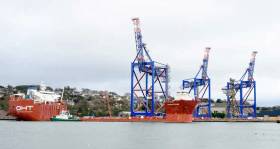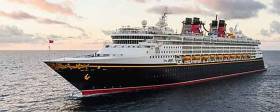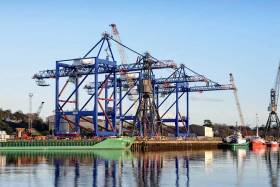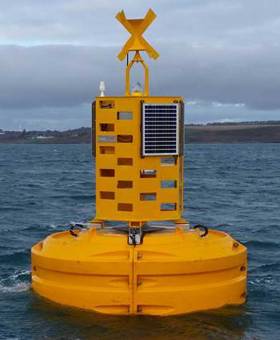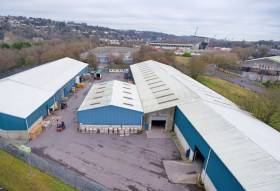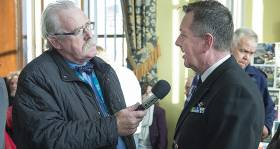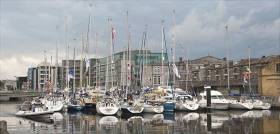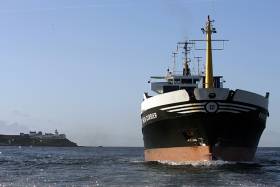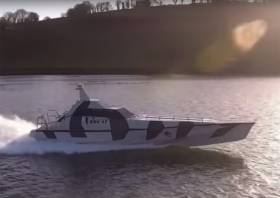Displaying items by tag: port of Cork
Opening Up Bantry Bay – A Maritime Hub In the South West
Bantry Bay is one of this island’s greatest maritime resources and is about to be opened up with a new marina very close to the centre of the town. Twenty-two miles long from its entrance and with 22 slipways and launching areas, plus a couple of islands, this can be a cruising mecca.
The Port of Cork Company which took over Bantry Harbour from the previous local harbour authority, has spent €9.5m. on the development of facilities there, turning the old pier area into a more extensive commercial facility, improving depth of access and providing in the inner harbour, a new marina. The development will operate under the aegis of the Bantry Bay Port Company.
All of this promises a new future for the harbour and Bantry as a maritime hub, not only for the leisure sailor, but for angling, fishing, other maritime activities and attracting more cruise ship visits by the improve facilities. The marina will provide 30/40 berths dependent upon size of vessel, dredged to a depth of 4 metres.
On this week’s THIS ISLAND NATION PODCAST, Cork and Bantry Harbour Master, Captain Paul O’Regan, outlines the development to me. I started by observing that nine-and-a-half million Euros was a big financial commitment to Bantry.
New Images Of Massive Cranes Loading Onto Ship In Cork Harbour
#CorkHarbour - The first of three Liebherr cranes has been loaded onto the Albatross heavy lift vessel at the Port of Cork.
As previously reported on Afloat.ie, the three 85-metre-tall cranes — each weighing more than 1,000 tonnes — are bound for Puerto Rico after being assembled from kit form at Cobh by employees from the Liebherr plan in Kerry.
Liebherr Marine has posted photos captured by drone as the first crane was loaded onto the specially adapted Albatross in Cork Harbour yesterday (Wednesday 22 February):
Disney Cruise Line is Coming to Cork Harbour in 2018
Disney Cruise Line has revealed its summer 2018 itinerary includes the Port of Cork on their list of first time visits.
2017 is already being described as one of the busiest cruise seasons in Cork with 69 cruise liners calling to the port.
The ‘Disney Magic’ will travel to Cork Harbour for the first time as part of Disney Cruise Line’s new seven-night British Isles cruise, departing in September 2018.
Announcing the first time call, Disney Cruise Line described Cork as ‘home to a vibrant culinary scene and a plethora of pubs, shops and cafes. It invites visitors to connect with Ireland’s ancient past, with historic sites like Blarney Castle, where visitors can kiss the famed Blarney Stone.’
Captain Michael McCarthy, Commercial Manager Port of Cork said: ‘After years of marketing the region and port capabilities, we are delighted to say the hard work has paid off and we are very excited to welcome Disney Cruise Line to our port in 2018. I have no doubt this call will be one of many into the future as we grow our relationship with Disney Cruise Line.’
Capable of holding over 3,700 passengers and crew, ‘Disney Magic’ is designed with primarily the family in mind. According to Disney Cruise Line the Disney Magic combines classic nostalgia and modern amenities with Disney’s signature service. From bow to stern, set sail for unforgettable storytelling that only Disney could bring to life.
Captain McCarthy continued: ‘this is a wonderful opportunity for the region particularly family attractions that are set to benefit from such cruise visits.’
Three cranes, each weighing more than 1,000 tonnes and 85 metres high will be loaded on to a massive ship next week in Cork Harbour bound for Puerto Rico. It will be an amazing feat of engineering and an equally spectacular sight at the Port of Cork to see the massive cargo depart Roches Point.
The cranes have been asembled from kit form having first been shipped by sea from Fenit in County Kerry to the Doyle Shipping Group Terminal at Rushbrooke in Cork Harbour.
60 employees from the Liebherr crane plant in Kerry have been constructing the massive cranes prior to their transatlantic voyage.
The specially adapted ship, The Albatross from Holland, arrived yesterday into the Port of Cork awaiting its giant cargo alongside at Cork Dockyard, as the photo below shows. Known as a 'heavy lift' vessel, the Albatross is 264.45 metres long and 42.54 metres wide, the ship has a maximum speed of 9.5 knots.
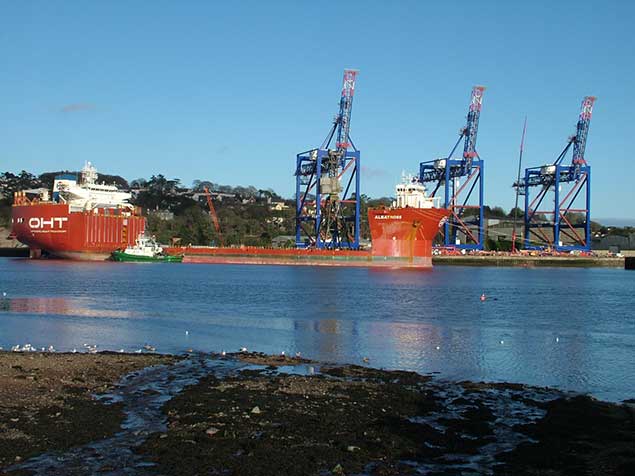 The heavy-lift ship, Albatross, is making maritime history in Cork Harbour this weekend having arrived at Cork Dockyard to transport three huge, fully-completed dock cranes to Puerto Rico Photo: Tom MacSweeney
The heavy-lift ship, Albatross, is making maritime history in Cork Harbour this weekend having arrived at Cork Dockyard to transport three huge, fully-completed dock cranes to Puerto Rico Photo: Tom MacSweeney
Tom MacSweeney in Cork Harbour adds: It is the first time that the Liebherr crane manufacturing company based at Killarney has exported fully-assembled cranes from Ireland for which they used the Cork Dockyard facility at Rushbrooke near Cobh to assemble them over the past few months.
The ship can automatically lie level alongside the dockyard quayside at all stages of the tide during the loading operation which is expected to take 4 to 5 days. Tracks will be laid to move the cranes onto the vessel.The Albatross will then move across Monkstown Bay to Ringaskiddy deepwater port where the cranes will be bolted to the ship and she will ballast for the voyage to Puerto Rico.
Wave Data Buoy Deployed at Port of Cork
TechWorks Marine has deployed an operational Wave Buoy by Port of Cork in late 2016, to be deployed at Roche’s Point on the approach to Cork Harbour.
As the Wave climate in Ireland takes its toll on equipment, a large platform was recommended in order to survive the heavy weather, and maximise visibility of the data buoy to the shipping activity using the harbour on a daily basis.
Central to this development is the TechWorks Marine TMBB-Data Acquisition and Transmission system, the versatile and configurable monitoring platform is designed around it. The TMBB is a robust, reliable and scalable data acquisition system, which ensures the ongoing collection and transmission of quality assured data to enable clients to make informed decisions linked to their commercial activity. Already operational, data is being transmitted in real-time every 20 minutes to the Port of Cork Operations station. The inertial wave sensor used on the buoy is the SeaView Systems SVS-603. The Mobilis Jet9000 buoy Hull was selected as the most robust and reliable platform for such long term operational deployment.
The engineering team at TechWorks Marine carried out the full system integration and testing and extensive onsite training was provided, combined with detailed hardware and software documentation. The TechWorks Marine Data buoy can be easily upgraded in the future with additional Meteorological and Oceanographic sensors given the modular structure of the TMBB system.
Ms Charlotte O’Kelly, CEO of TechWorks Marine confirmed that the Wave buoy was deployed operationally in early December following initial on-site testing by TechWorks Marine. Ms O'Kelly said: ‘At present, the data buoy reports directly to the Port of Cork operations centre from where its data is used to ensure the safety of ships coming in and out of the Harbour.’
Port of Cork Harbour Master, Captain Paul O Regan commented on the wave buoy saying: ‘To date the wave data we have collected has been extremely useful with regards to our shipping operations. Safety is our first priority at the Port of Cork and this technology will assist us as we see larger vessels arriving into the port.’
Cork Docklands Site Comes To Market
#CorkHarbour - More than three acres of Cork docklands are coming to market, as the Irish Examiner reports.
The lands comprise a warehouse property between Monahan Road and Centre Park road east of the city centre, in an area already set for transformation between the revamped Páirc Uí Chaoimh and the new Marina Park regeneration project, adjacent to Cork City Marina by the former showgrounds.
Commercial and residential developers alike are expected to express interest in the 3.31-acre site, zoned for mixed use, and with a guide price of €1.2 million per acre.
Interest in this part of the city is growing with the imminent move of the Port of Cork downriver — and city planners are already meeting with potential buyers for the port’s historic buildings on Custom House Quay.
The Irish Examiner has more on the story HERE.
Podcast – Meitheal Mara Plan For Cork & A Voyage for Mad Men
Hello there and welcome aboard this week’s edition of Seascapes the maritime programme, this week we hear about the future plans of Meitheal Mara; we have music from Gordon Lightfoot and the epic tale of “The Wreck of the Edmund Fitzgerald” and a talk in the Poolbeg Yacht and Boat Club in the coming week titled “A Voyage for Madmen – the Golden Globe Race- 1968 to 2018 “ with Gregor McGuckin who has entered next years edition of the race, writer and broadcaster Norman Freeman takes us on a visit to Bray Head in County Wicklow , we have the winner in our Seascapes competition for that book on the “ Rivers Dodder and Poddle”....first this week on your maritime programme we hear about the future strategic plans for Meitheal Mara based in the heart of Cork city , the plan was launched in the splendid boardroom of The Port of Cork by Minister Simon Coveney TD ,Meitheal Mara was founded in 1993, the event was attended by over one hundred partners , supporters and sponsors of the organisation, in a moment we’ll hear from John Mullins CEO of The Port of Cork and from Chief of Staff of the Defence Forces, Vice Admiral Mark Mellett....Meitheal Mara is a maritime heritage community for young people and adults, we talked first to one of the founders , seafarer boatman and boat builder and maritime advocate Padraig O Duineen .....
Well from Padraig O Duineen of Meitheal Mara to John Mullins , CEO of the Port of Cork .....
The voice of John Mullins, Chairman of the Port of Cork Company, next to the Chief of Staff of the Defence Forces – Vice Admiral Mark Mellett
Vice Admiral Mark Mellett at that launch of Meitheal Mara’s Strategic Plan for the coming years which was launched last Friday afternoon , you can read more about the organisation here.
Next here on Seascapes to the East coast and writer and broadcaster Norman Freeman on Bray Head.....
Writer and broadcaster Norman Freeman whose latest book “The Lure of Far Away Places “ is published by The Liffey Press and in all discerning bookstores.
We recommend you see Eugeen Van Mieghem – An exhibition of his paintings in ” Port Life “ at The Hugh Lane Gallery described as a fascinating visual account of the pulsating life of a working port at the beginning of the 20th century.
Van Mieghem’s work represents a social history, exploring themes of migration, globalisation, port society, the working community, and, the life of the artist .
Organised with the support of Dublin Port Company, the exhibition is part of Port Perspectives, Dublin Port’s arts commissioning programme to help re-establish links between the Port and the City.
The exhibition can be viewed Tuesday to Thursday 9:45 am – 6 pm, Friday 9:45 am – 5 pm, Saturday 10 am – 5 pm and Sunday 11 am – 5 pm. Admission is free of charge (voluntary contributions to the Gallery are appreciated).
Next to an epic song on a maritime disaster from the pen of songwriter supreme Gordon Lightfoot and “The Wreck of the Edmund Fitzgerald”
The wreck of the Edmund Fitzgerald” written and performed by Gordon Lightfoot.....
The Department of Transport, Tourism and Sport has launched its new Seafarers web resource for all seafarers, fishers, recreational craft users and others looking to obtain certification or qualification in the sector.
The new website they state is “ intended as a national and international resource for information relating to seafarers, which includes those involved in commercial shipping, the fishing industry and the recreational craft sector.”
The site provides full details of the career structures available and how to obtain the necessary qualifications for work in the industry, as well as for recreational craft users.
The website hosts all appropriate application forms and also provides for the verification of qualifications, listing details of approved training course providers in Ireland.
The Department of Transport , Tourism and Sport says the Seafarers website forms part of a wider updating of seafarer education and training in Ireland, and is supported by a new Seafarers Information System, which provides for the registration of all seafarers and for life-long training and career development.
The department encourages seafarers who already hold Certificates of Competency or radio certificates issued in Ireland to register now on the new information system.
"A Voyage For Madmen"- The Golden Globe Race 1968-2018. An illustrated lecture by Gregor McGuckin, who has entered for the 2018 race, will take place on Thursday 2nd February at 20:00hrs at the Poolbeg Yacht & Boat Club, Ringsend,. There will be an entry fee of €5 in aid of the RNLI.
World Wetlands Day is coming up on February 2nd , and this year’s theme is ‘Wetlands for Disaster Risk Reduction’.
Wetlands play a vital role in mitigating the impact of extreme weather events.......that’s next Thursday “World Wetlands Day.....”
Finally to our Seascapes competition and the copy of “The Rivers Dodder and Poddle - Mills , Storms and Droughts and the Public Water Supply” by Don McEntee and Michael Corcoran and published by Dublin City Council and Four Courts Press - the first correct answer out of the Seascapes fedora was from Tessie McGettigan , Lifford , Co Donegal , Congratulations that book is on its way to you......many thanks for all your entries....
“ On the sound desk on Seascapes this week Bryan Fitzpatrick , next week here on your maritime programme we bring you a full report from the Volvo –Irish Sailing Association Annual Awards at the Royal Dublin Society Concert Hall in Ballsbridge , where they will present the ISA Training Centre of the Year ; Youth Sailor of the Year ; Afloat.ie Sailor of the Year and the ISA President's Awards; all that and much more .......so until next Friday night, tight lines and fair sailing.”
Irish Sailing Association Host Cruising Conference in Port of Cork
The Irish Sailing Association’s 2017 Cruising Conference takes place this year on Saturday, 18 February at the historic Port of Cork offices in Cork city.
The conference is a chance for sailors to hear and discuss the latest knowledge and insights from marine experts, as well as network with a community of their peers. It is sponsored by Union Chandlery and supported by the Cruising Association of Ireland.
This year’s line-up of speakers include Ballymaloe chef Rachel Allen who will discuss recipes from her cookbook “Coast” and look at all the food available along Ireland’s Atlantic coast, from Cork to Donegal.
The conference will also hear from the RNLI (and how to avoid them at sea), the latest research from Irish Lights, stories from a woman-over-board, as well as learn about predicting the weather, unusual tides, and tales on surviving a round-the-world cruising trip.
Tickets for the conference are available here
Port of Cork Handles 9.2m Tonnes Of Trade
Total traffic through the Port of Cork reached 9.2 million tonnes in 2016, a slight decrease compared to 2015 traffic. Import figures remain steady while exports were reduced primarily due to the closure of Lisheen Mines in Co. Tipperary and the subsequent cessation of exporting lead and zinc through the Port of Cork in 2016.
Total container volumes through both Tivoli and Ringaskiddy Container Terminals grew by 2% compared to 2015 figures, with over 209,000 TEU’s handled. The growth in container handling at the Port of Cork is very encouraging particularly as the Port moves to redevelop Ringaskiddy Port as their main container terminal. In 2016 the largest container vessel to visit an Irish Port called to Ringaskiddy on route from Central America. This weekly service not only ensures the Irish grocery market is fully supplied with fresh fruit, but positions Cork as deep sea port capable of handling panamax size container vessels.
Trade in Dry bulk cargos such as animal feed, fertilisers and cereals saw a marginal decrease while liquid bulk cargo, predominantly the oil traffic handled through Whitegate Oil Refinery now Irving Oil, also reported a slight decrease. Positively, in 2016 family owned Canadian company Irving Oil acquired Phillips 66, securing the future of Whitegate Oil Refinery. This positive step was welcomed by the Port of Cork and will ensure Ireland remains competitive within the global oil market and has a security of supply of crude products that can be refined within the Irish State and not be totally dependent on international events. Whitegate supplies 30-40% of the Irish refined fuel market through its road loading facility and by sea to Irish and international ports over its marine jetty.
Speaking about the 2016 trade traffic figures the Port of Cork Chairman Mr. John Mullins said: ‘The trade results for the Port of Cork in 2016 are overall very encouraging despite some decreases in certain trades. We are very pleased with the results as achieving traffic figures which are in line with pre-recessionary time highlights the positivity returning to the market and I am confident that the port can sustain this growth across 2017. In particular container traffic through Tivoli and Ringaskiddy increased by 2% with imports fractionally higher than exports. There was impressive growth in the imports of trade cars with over 46,000 vehicles imported.’
He continued: ‘In addition to the overall trade traffic figures, the Port of Cork’s cruise business has gone from strength to strength with a total of 58 liners visiting Cork during 2016. This high number of calls brought over 127,000 passengers and crew, helping to drive visitors to the region. Furthermore, in 2016, Cobh was named the second Best Cruise Destination in the British Isles & Western Europe in the first-ever Cruise Critic Cruisers’ Choice Destination Awards, which we are immensely proud of. In 2017 69 cruise liners are scheduled to call and 2018 is looking even stronger.’
2016 saw Brittany Ferries operating another successful year with their service from Cork to Roscoff carrying almost 80,000 passengers in 2016 and it is anticipated that 2017 will be another busy year for Brittany Ferries when sailings resume in March.
In 2015 An Bord Pleanala granted a 10-year planning permission to Port of Cork for the redevelopment of the existing port facilities at Ringaskiddy. In July 2016 the Port of Cork submitted to the Board a request to alter the terms of the permission granted to enhance the long-term sustainability of the port. The €80 million port redevelopment will future proof the facility and Port of Cork look forward to the project progressing in 2017.
Safehaven’s ‘Thunder Child’ Put Through Its Paces In Stormy Cork Harbour
#ThunderChild - Stormy winter seas made the perfect proving ground for a new state-of-the-art naval patrol and rescue vessel tested in Cork Harbour recently, as the Irish Examiner reports.
But it’s just the beginning for Thunder Child – the latest high-tech design from Cork-based Safehaven Marine, makers of the James Bond-style Interceptor, Barracuda – which was launched from the Port of Cork last month.
Safehaven’s managing director Frank Kowalski has his sights set on breaking the record for the fastest circumnavigation of Ireland — including a 1,000km open-sea loop around Rockall.
And considering the sleek wave-cutting vessel has already clocked speeds of over 100kph in testing, and is kitted out to handle the stormiest situations, it should be well up to the task of that challenging route.
The Irish Examiner has more on the story HERE.



























